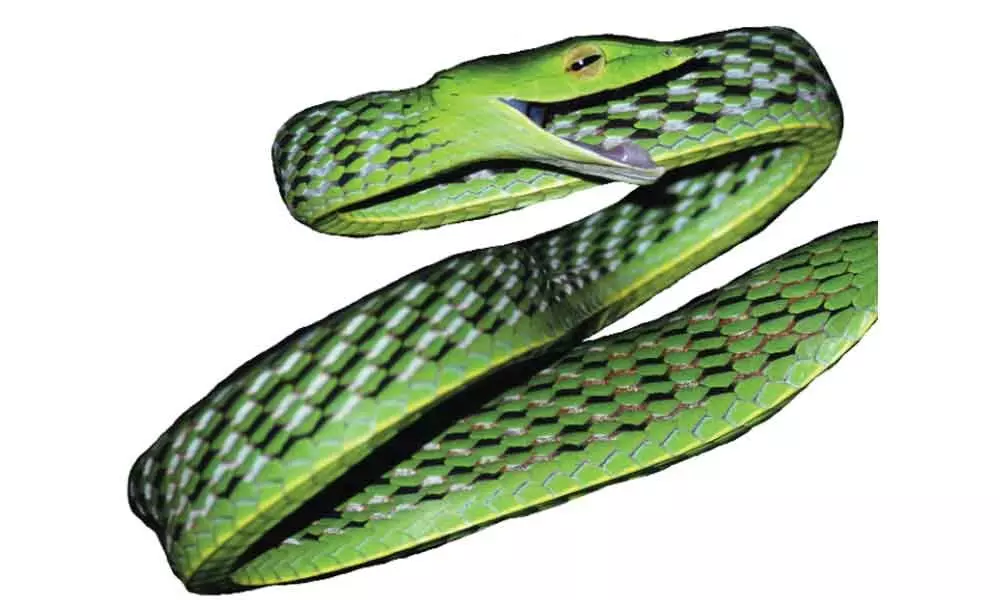Live
- IG inspects police stations at Chirala, Karamchedu
- Sandard Glass raises Rs40 cr in pre-IPO deal
- Options data flags rising volatility
- Contrarians in sight amid low volumes-led pull back rally
- ‘Ksheera Sagara Madhanam’ enthrals audience
- Nifty back below 200EMA/ 200DMAs
- US Navy shoots down own jets over Red Sea
- Nara Devansh sets world record in chess
- Team India cross their fingers
- 3 energy efficient projects to reduce power bills in AP
Just In
Researchers find five new species of vine snakes


Vine snakes are among the most common snakes, found even in many peri-urban areas wherever there is some greenery.
Bengaluru: Vine snakes are among the most common snakes, found even in many peri-urban areas wherever there is some greenery. This species is believed to be widespread throughout the drier parts of the peninsula as well as in the Western Ghats. New research shows that vine snakes actually comprise several different species. Based on extensive sampling across peninsular India, a team of researchers from the Centre for Ecological Sciences (CES), Indian Institute of Science (IISc) have now described several new species of vine snakes from the region.
Led by former student Ashok Mallik as part of his doctoral research, the team carried out field visits across India to collect morphological data, tissue samples and specimens to understand the patterns of distribution and diversification of vine snakes.
Asian vine snakes, distributed throughout the continent, belong to the genus Ahaetulla and the recently described as Proahaetulla.
As stated in the IISc release, once the team started its research, they were surprised to discover that the common green vine snake also known as Ahaetulla nasuta in India was a complex of several species. They found four distinct small-bodied and short-nosed species: the Northern Western Ghats vine snake (Ahaetulla borealis), Farnsworth's vine snake (Ahaetulla farnsworthi), Malabar vine snake (Ahaetulla malabarica) and Wall's vine snake (Ahaetulla isabellina) in the Western Ghats rainforests alone. These species were superficially similar in their morphology but separated by geographic (or ecological) barriers. Another morphologically distinct and much larger species, the long-nosed vine snake (Ahaetulla oxyrhyncha), was distributed in the lowlands and drier parts of peninsular India.
"All the vine snakes were assigned names related to the locality or based on a morphological character, but we named the species Ahaetulla farnsworthi after my favourite scientist who inspired me to become one, Dr. Hubert Farnsworth from [the cartoon] Futurama. In fact, the snake also looks a lot like him," says Achyuthan Srikanthan, a researcher at CES who was part of the team.
The team also delineated the Travancore vine snake (Ahaetulla travancorica), separated by morphology and a geographic barrier from the Gunther's vine snake (Ahaetulla dispar). Finally, they recognised morphological distinctions between the brown vine snake in the Western Ghats and the one found in Sri Lanka, and gave the Western Ghats form a new name (Ahaetulla sahyadrensis). There are now six species of vine snakes endemic to the Western Ghats.
Mallik says, "Widely distributed species may comprise many cryptic species, which can only be detected by genetic analysis. Our earlier discovery of another deeply divergent vine snake Proahaetulla antiqua suggests that the entire lineage of vine snakes (Ahaetulla) evolved around 26 million years ago during the mid-Oligocene from its sister group Proahaetulla."
Kartik Shanker, Associate Professor at CES says, "The discovery helps us document species diversity but also sheds light on the evolutionary history of vine snakes in South Asia. Ahaetulla nasuta is one of the first snake names that we learned as aspiring herpetologists. One almost feels sad that we had to assign it to the Sri Lankan population, but it is far more exciting that we have all these new species in India."
The study, published in the journal Zootaxa, was carried out in collaboration with researchers SR Ganesh from the Chennai Snake Park, Saunak Pal from the Bombay Natural History Society, and Princia D'souza from IISc.

© 2024 Hyderabad Media House Limited/The Hans India. All rights reserved. Powered by hocalwire.com






